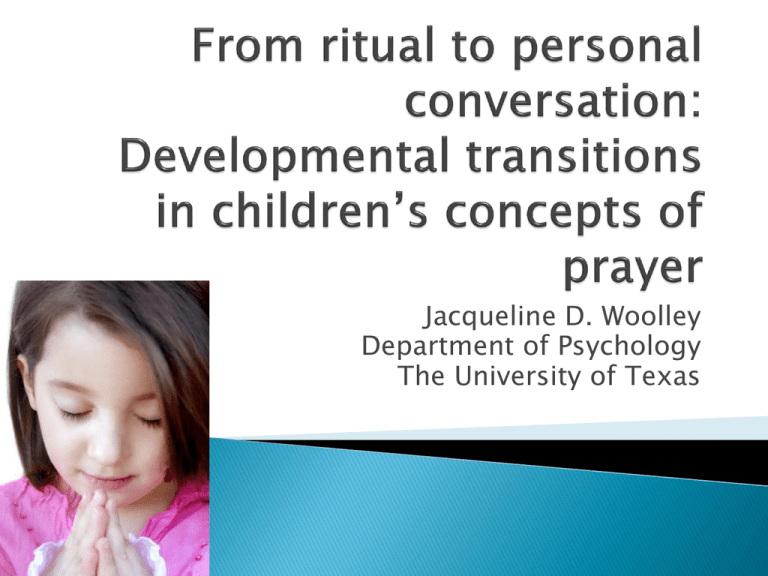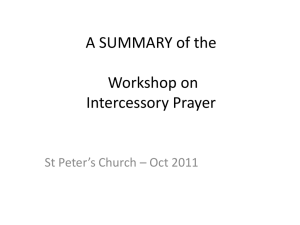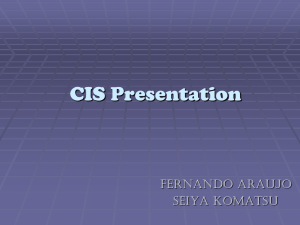templeton.prayer
advertisement

Jacqueline D. Woolley Department of Psychology The University of Texas Children’s concept of prayer ◦ As ritual ◦ As personal conversation Increased attention within psychology to children’s religious and spiritual development Developmental transitions in children’s concept of prayer Woolley & Phelps, 2001; Bamford & Lagatutta, 2010 Increased attention to use of prayer in therapy with children Walker, Doverspike, Ahmed, Milevsky, & Woolley, in press Does children’s concept of prayer develop from one in which prayer is primarily understood as ritual to one in which prayer is viewed as a personal conversation with God? How is children’s concept of prayer related to their beliefs about its efficacy in ameliorating emotional distress? How does this vary as a function of children’s religious background? Four- to 10-year-old children from 2 Christian and 2 Jewish denominations Primary tasks: Understanding of prayer as ritual and as private conversation with God Additional tasks ◦ ◦ ◦ ◦ Awareness of different types of prayer Concept of God Individual differences in creativity, theory of mind Family religiosity differences (parent questionnaire) Age: Children between the ages of 4 and 10. ◦ Previous research in my lab (Woolley & Phelps, 2001) shows that 4-year-old Christian children have a rigid notion of prayer, believing that it can only be engaged in at certain times and in certain places. ◦ Research by Bamford and Lagatutta (2010) shows that, whereas younger children claim that positive emotions motivate prayer, older children (by age 8) claim that both negative and positive emotions motivate prayer. Religious background: Christian, Jewish ◦ Christianity. Prayer is practiced both communally and privately. There are few requirements regarding characteristics of person/people praying. Catholicism – more ritualistic Methodistism – less ritualistic ◦ Judaism. Prayer is practiced primarily communally. Ideal form of prayer involves at least 10 Jewish males. Prayers are chanted and meticulously scripted. Orthodox – closer adherence to restrictions (more ritualistic) Reformed – loosening of restrictions (less ritualistic) ◦ 1. Children’s conception of prayer as ritual versus as private conversation with God ◦ 2. Beliefs about motivations for engaging in each type of prayer and potential outcomes of engaging in each type of prayer. ◦ These will be assessed by the use of A) interviews B) story tasks – children predict character’s behavior, story is completed, children explain why and predict character’s emotional outcome Different types of prayer “Gimme!” “Thanks!” “Oops!” “Wow!” - Rabbi Marc Gellman Concepts of God ◦ Anthropomorphism Does the extent to which children grant human-like characteristics to God affect their understanding of prayer as conversation? ◦ Beliefs about God’s abilities What kinds of acts is God capable of? ◦ Beliefs about God’s temperament Is God mean or nice? Creativity Ability to generate personal prayers Existence of Imaginary Companion Expertise in communicating with unseen other Theory of Mind Advanced social and perspective taking skills 1. Children may develop from holding a ritualistic view of prayer to viewing prayer as a personal conversation with God. 2. Children may view personal conversation with God as more therapeutic than ritual prayer. 3. These may vary by religious background. 4. This information will inform us about children’s religious and spiritual development and can also be used to structure prayer interventions in therapy.








